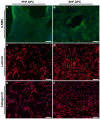Transcriptome sequencing reveals differences between primary and secondary hair follicle-derived dermal papilla cells of the Cashmere goat (Capra hircus)
- PMID: 24069460
- PMCID: PMC3777969
- DOI: 10.1371/journal.pone.0076282
Transcriptome sequencing reveals differences between primary and secondary hair follicle-derived dermal papilla cells of the Cashmere goat (Capra hircus)
Abstract
The dermal papilla is thought to establish the character and control the size of hair follicles. Inner Mongolia Cashmere goats (Capra hircus) have a double coat comprising the primary and secondary hair follicles, which have dramatically different sizes and textures. The Cashmere goat is rapidly becoming a potent model for hair follicle morphogenesis research. In this study, we established two dermal papilla cell lines during the anagen phase of the hair growth cycle from the primary and secondary hair follicles and clarified the similarities and differences in their morphology and growth characteristics. High-throughput transcriptome sequencing was used to identify gene expression differences between the two dermal papilla cell lines. Many of the differentially expressed genes are involved in vascularization, ECM-receptor interaction and Wnt/β-catenin/Lef1 signaling pathways, which intimately associated with hair follicle morphogenesis. These findings provide valuable information for research on postnatal morphogenesis of hair follicles.
Conflict of interest statement
Figures






References
-
- Bitgood MJ, McMahon AP (1995) Hedgehog and Bmp genes are coexpressed at many diverse sites of cell-cell interaction in the mouse embryo. Dev Biol 172: 126–138. - PubMed
-
- Oro AE, Scott MP (1998) Splitting hairs: dissecting roles of signaling systems in epidermal development. Cell 95: 575–578. - PubMed
-
- Millar SE (2002) Molecular mechanisms regulating hair follicle development. J Invest Dermatol 118: 216–225. - PubMed
Publication types
MeSH terms
LinkOut - more resources
Full Text Sources
Other Literature Sources

